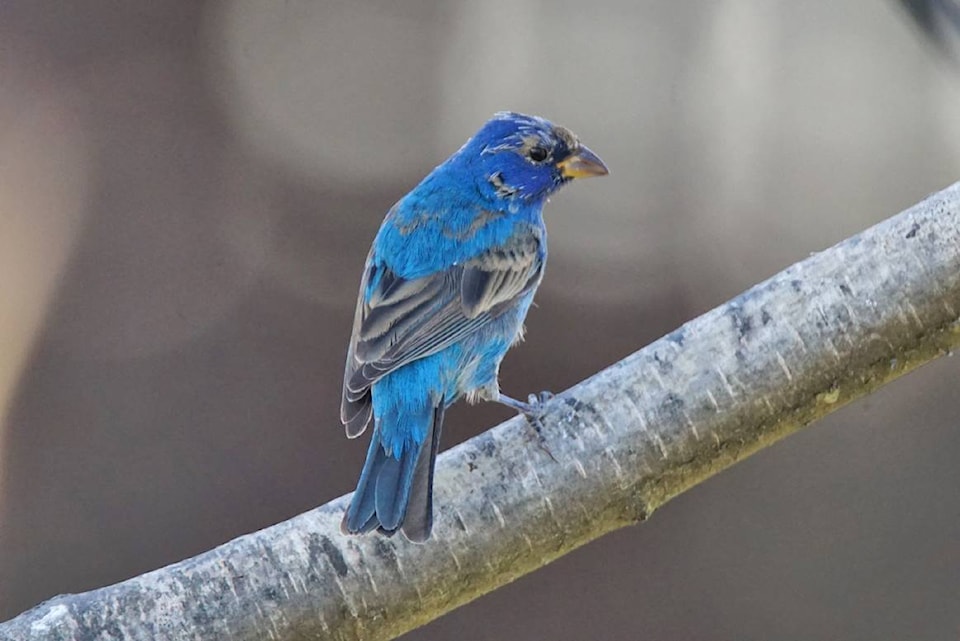Sandy McRuer
Special to the News
I was walking the dog last week. It was a regular route. It was a mundane task but I always bring my binoculars on the dog walk because you never know what could pop up. And sure enough, an indigo bunting popped up.
In the summer indigo buntings are brilliant blue migratory birds that live in Manitoba east to Montreal and south to Point Pelee National park, the southernmost tip of Canada. In the winter they are a drab brown colour and are found in the southern half of Mexico. So what the heck is it doing here? And is this real? Or have I finally gone mad?
Well no. This does happen once in a very long while. It’s called vagrancy among biologists. And a birder who finds one of these vagrants is a lucky person indeed. Because birding, as a hobby, is like a scavenger hunt with a list that can include the whole world or just your backyard. It’s not all that competitive, although one can compete with friends to see who finds more species.
The first thing one does when one sees a rare bird such as this is to tell someone and then to document it. Documenting these days means taking a photo of it. So I called another birder in town with a better camera than I have, Penny Hall. She went there the next day and got a photo. Then I sent an email out to all the others in the Birding Community, and to a Yahoo Group called BCVIBIRDS. Since then at least 25 others from all over the island have come to see it. And many of them also visited Penny’s home as she has had a Harris’s Sparrow visiting all winter. Its winter home is the Mississippi Valley. But these sparrows are known for wandering.
There are several possible reasons why this bunting ended up so far away from its usual haunts. It could be a young inexperienced bird, and had lost contact with others of its kind during migration. Storms could have blown it off course. It could be a wanderer. Some kinds of birds are known to regularly wander outside their normal ranges. Or it could be a genetic abnormality that has impaired its biological compass.
In this case, I think it is the last choice. I’m not sure how old this bird is so it could be an inexperienced young one. But species that need experience are generally flocking birds. Buntings don’t flock. Storms generally come out of the west around here. So birds blown off course would be from Asia not Ontario. Buntings do wander a bit and this is more likely than the first two. But my money is on a weird genetic thing. All the other bunting sightings in BC have been in summer or fall. No other sighting has been in winter.
This mention of sightings leads me to a short digression. There is a HUGE database on line called eBird, where tens of thousands of people post their sightings every day all over the world, including GPS coordinates, photos and even songs and calls. Those are the sighting I’m talking about. Birding is enormously popular all over the States, Canada, Australia and all over the world. And the data is powerful; so powerful, you can watch an animated map of the swallow migration across North America.
There is a possibility that this indigo bunting has been here all winter. It has access to a steady source of food, supplemented by whatever else can be scrounged around here. But it likely won’t stay much longer. It is molting from its drab grey-brown look to a coat of feathers that is a brilliant indigo blue. That means it is getting ready to migrate to its home somewhere far east of here.
Sighting like these have been going on for many, many years. The ranges of birds, as in any other life forms are always shifting. Some of it is due to changing climates. But birds are also pushing back so to speak; exploring new opportunities in far off lands. An excellent example is the Eurasian collared-dove. In 40 years, it has spread across North America from a little colony in the Bahamas.
Before I go, I just want to put a plug for the Friday Afternoon Birding. Bring your binoculars and see what it is all about. 12:30PM, at Victoria Quay, every Friday.
